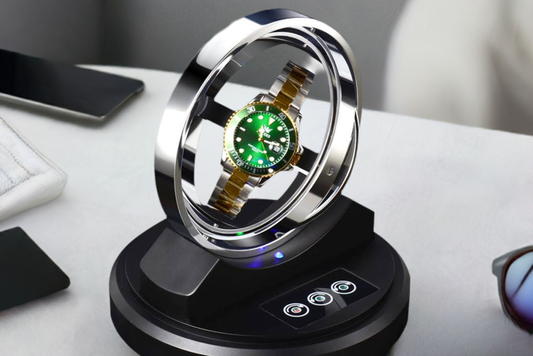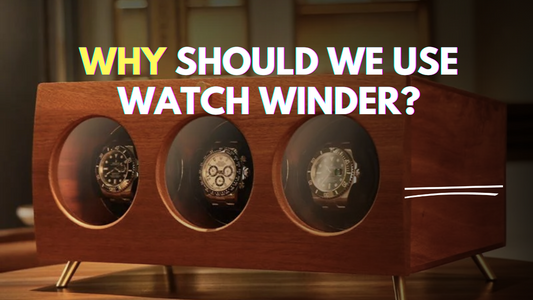Discover the secrets to maximizing the lifespan of your cherished timepieces. Whether you're an automatic or mechanical watch enthusiast, understanding the factors that influence their longevity is crucial. This guide delves into the world of horology, revealing how with proper care, these timeless wonders can last a lifetime and beyond.
The Basics: Automatic vs. Mechanical Watches
Credit: YouTube Channel - Λsk Λbout Solutions
Automatic Watches 101: Self-winding Magic and Their Inner Workings
Automatic watches, also known as self-winding watches, are a type of mechanical watch that harnesses the wearer's movements to wind the mainspring, eliminating the need for manual winding. This innovative technology was first introduced in the 18th century and has since become a staple in the watchmaking industry.
The inner workings of an automatic watch are fascinating. The watch contains a rotor, a half-moon-shaped weight that oscillates with the wearer's movements, generating energy. This energy is then stored in the mainspring, which powers the watch's gears and hands. The rotor is connected to a clutch, which ensures that the mainspring is wound only in one direction, preventing it from unwinding.
One of the most significant advantages of automatic watches is their convenience. Once fully wound, an automatic watch can run for several days without the need for manual winding. This makes them ideal for everyday wear. Additionally, automatic watches are often more accurate than manual-winding watches, as the consistent energy supply ensures a steady rhythm.
Mechanical Watches Unveiled: The Art of Manual Winding and Its History
Mechanical watches, on the other hand, require manual winding to store energy in the mainspring. This process involves turning the watch's crown to wind the spring, which then powers the watch's gears and hands. Mechanical watches have a rich history, dating back to the 16th century when they were first invented.
The art of manual winding is a delicate process that requires a gentle touch. The wearer must turn the crown in a clockwise direction to wind the spring, taking care not to overwind it, which can damage the watch's mechanism. This process not only winds the watch but also sets the time and date.
Mechanical watches are often prized for their craftsmanship, beauty, and historical significance. They are considered works of art, with intricate engravings, ornate decorations, and precision engineering. The Patek Philippe Calatrava, for example, is a highly sought-after mechanical watch known for its sleek design, intricate mechanics, and exceptional craftsmanship.
How Long Do Watches Typically Last?
The lifespan of both automatic and mechanical watches can vary significantly, depending on several factors such as the quality of the watch, usage, and maintenance. Here are some general expectations and exceptional cases:
Average Lifespan
-
Automatic Watches: Automatic watches, which use a self-winding mechanism to power the watch, can last for quite a long time if properly maintained. On average, a well-made automatic watch can last between 10 to 30 years before needing significant repairs or replacement. This is because the automatic mechanism can continue to generate power as long as the watch is worn regularly. However, the accuracy and reliability of the watch may degrade over time due to wear on the mechanical components.
-
Mechanical Watches: Mechanical watches, which rely on a manual winding mechanism, can also have a long lifespan. With proper maintenance and regular winding, a high-quality mechanical watch can last for 20 to 50 years or more. The key to their longevity lies in the intricate craftsmanship and the careful selection of materials used in their construction.
Exceptional Cases
-
Century-Old Watches: There are instances where mechanical watches have been known to last for over a century. For example, some antique pocket watches from the 19th century are still functional today, albeit with occasional maintenance and restoration. These exceptional cases demonstrate the craftsmanship and durability of well-made mechanical watches.
-
Record-Breaking Watches: Some watches have been designed to push the limits of longevity. For instance, the "Oscillon" watch, created by the Swiss watchmaker Vacheron Constantin, is designed to last for at least 250 years without needing significant repairs. This is achieved through the use of advanced materials and innovative mechanisms that minimize wear and tear.
-
Historical Significance: Watches have played significant roles in history, such as the Omega Speedmaster worn by astronauts during the Apollo missions. These watches have become iconic symbols of human achievement and can last for generations as historical artifacts, even if they are no longer in use as timekeeping devices.
Factors Influencing Watch Longevity
When it comes to the longevity of automatic and mechanical watches, several key factors come into play. Understanding these factors can help watch enthusiasts ensure that their timepieces last for generations to come.
Maintenance Schedule: The Key to a Long Life
Regular maintenance is crucial for extending the life of an automatic or mechanical watch. A well-maintained watch can last for decades, while neglecting regular servicing can significantly reduce its lifespan. According to the Watchmaker's Guide, a mechanical watch should be serviced every 3 to 5 years, depending on usage and environmental conditions. During a routine service, the watchmaker will inspect the watch, clean and lubricate the movement, and replace any worn-out parts. This process ensures that the watch continues to function accurately and efficiently.
Environmental Factors: Temperature, Humidity, and Shocks
Environmental factors such as temperature, humidity, and shocks can significantly impact the longevity of an automatic or mechanical watch. Extreme temperatures, for example, can cause the lubricants in the movement to break down, leading to increased friction and wear on the components. According to a study by the Swiss Watch Industry, temperatures above 40°C (104°F) or below -10°C (14°F) can reduce the lifespan of a mechanical watch by up to 20%.
Humidity is another environmental factor that can affect the longevity of a watch. High humidity can cause moisture to seep into the watch, leading to corrosion and damage to the components. The International Organization for Standardization (ISO) recommends that watches be designed to withstand humidity levels of up to 80%. Watches that are not designed to withstand high humidity levels may experience reduced lifespans.
Shocks and impacts can also significantly impact the longevity of an automatic or mechanical watch. A single severe impact can cause damage to the movement, leading to costly repairs or even complete failure of the watch. According to a study by the Horological Institute of America, a watch that is subjected to regular shocks and impacts can experience a reduced lifespan of up to 30%.
Quality of Materials: The Role of Premium Components in Durability
The quality of materials used in the construction of an automatic or mechanical watch plays a significant role in its durability. Premium materials such as stainless steel, titanium, and gold are more resistant to corrosion and wear than lower-quality materials. According to a study by the Watch Material Institute, watches constructed with premium materials can last up to 50% longer than those constructed with lower-quality materials.
For example, the Rolex Submariner, which is constructed with high-quality stainless steel, has a lifespan of up to 20 years with proper maintenance. In contrast, a lower-quality watch constructed with base metals may only last for 5 to 10 years. The use of premium materials also ensures that the watch is more resistant to scratches and damage, further extending its lifespan.
Maintenance and Servicing of Automatic and Mechanical Watches
Service Intervals: Debunking the Myth
When it comes to determining the ideal service interval for an automatic or mechanical watch, there is a common misconception that a strict schedule must be followed. However, the reality is that the frequency of servicing depends on various factors, including the watch's usage, environment, and quality of construction.
Traditionally, watchmakers and manufacturers have recommended servicing every 5 to 10 years. For instance, Omega suggests servicing their mechanical watches every 5 to 7 years, while Rolex recommends every 10 years. However, some high-end watch brands, such as Patek Philippe, may recommend servicing as frequently as every 3 to 5 years.
In reality, the service interval can vary significantly. For example, a watch worn daily in harsh environments, such as near the ocean or in extreme temperatures, may require more frequent servicing, potentially every 2 to 3 years. On the other hand, a watch that is rarely worn or stored in a controlled environment may only need servicing every 15 to 20 years.
Ultimately, the best way to determine the service interval for your watch is to consult the manufacturer's guidelines and have your watch regularly inspected by a qualified watchmaker. They can assess the watch's condition and provide personalized recommendations for maintenance and servicing.
What Happens During a Service: A Detailed Look
A watch service involves a comprehensive series of procedures to ensure the timepiece is functioning accurately and efficiently. Here is an overview of the typical steps involved:
-
Initial Inspection: The watchmaker visually examines the watch to identify any visible signs of wear or damage.
-
Disassembly: The watch is disassembled, and each component is carefully cleaned and inspected. This includes the movement, dial, hands, and case.
-
Movement Cleaning and Lubrication: The movement is thoroughly cleaned to remove dirt and old lubricants. New lubricants are then applied to the gears and bearings to ensure smooth operation.
-
Component Replacement: Any worn or damaged components, such as bearings, springs, or gears, are replaced with genuine or equivalent parts.
-
Reassembly and Adjustment: The watch is reassembled, and the movement is adjusted to ensure accurate timekeeping.
-
Water Resistance Testing: If the watch is water-resistant, it undergoes a pressure test to ensure the seals and gaskets are functioning properly.
-
Final Inspection and Testing: The watch is thoroughly inspected and tested to ensure it meets the manufacturer's specifications and is functioning correctly.
The cost of a watch service can vary significantly, depending on the brand, model, and type of service required. On average, a basic service can cost between $200 and $500, while a more comprehensive service or restoration can range from $1,000 to $5,000 or more.
DIY Care Tips: Simple Steps to Keep Your Watch Ticking
While regular servicing by a professional watchmaker is essential, there are simple steps you can take to maintain your watch at home:
-
Regular Cleaning: Gently wipe the watch case and band with a soft cloth to remove dirt and oils from your skin.
-
Avoid Extreme Temperatures: Keep your watch away from extreme temperatures, such as those near a fireplace or in a hot car.
-
Magnetic Field Protection: Avoid exposing your watch to strong magnetic fields, such as those found near speakers or refrigerators.
-
Water Resistance Maintenance: For water-resistant watches, ensure the crown is securely tightened, and avoid exposing the watch to water at depths beyond its rated capacity.
-
Battery Replacement: For quartz watches, replace the battery every 1 to 2 years, or as recommended by the manufacturer.
The Impact of Wear and Tear on Automatic and Mechanical Watches
Automatic and mechanical watches are intricate timepieces that require regular maintenance to ensure their longevity. The wear and tear on these watches can significantly impact their accuracy, reliability, and overall lifespan. In this section, we will discuss the common wear points and signs that indicate a watch needs attention.
Common Wear Points
-
Gear Train: The gear train is one of the most critical components of a mechanical watch. It is responsible for transmitting power from the mainspring to the hands of the watch. Over time, the gears can wear down, leading to a loss of accuracy and power reserve.
-
Bearings: The bearings in a mechanical watch are responsible for reducing friction between moving parts. As the watch ages, the bearings can wear out, causing increased friction and wear on other components.
-
Mainspring: The mainspring is the power source for mechanical watches. As it ages, it can lose its ability to store energy, leading to a decrease in power reserve.
-
Balance Wheel: The balance wheel is responsible for regulating the timekeeping of a mechanical watch. As it wears down, it can affect the accuracy of the watch.
-
Jewels: Jewels are used in mechanical watches to reduce friction and wear on moving parts. Over time, the jewels can wear down, leading to increased friction and wear on other components.
Signs Your Watch Needs Attention
-
Inaccuracy: If your watch is consistently losing or gaining time, it may be a sign that the gear train or balance wheel needs adjustment or replacement.
-
Power Reserve Issues: If your watch is not maintaining its power reserve, it could indicate that the mainspring needs to be replaced.
-
Rust or Corrosion: If you notice rust or corrosion on any of the watch's components, it is essential to have it serviced immediately to prevent further damage.
-
Noise or Vibration: If your watch is making unusual noises or vibrating excessively, it could be a sign that the bearings or gear train need to be serviced.
-
Visible Wear: If you notice visible signs of wear on the watch's case, band, or other components, it may be a sign that the watch needs to be serviced or refurbished.
Preserving History: Ensuring Your Watch Becomes a Family Treasure
When it comes to automatic and mechanical watches, their longevity and potential to become family heirlooms are significant aspects of their allure. These timepieces, often crafted with precision and attention to detail, can indeed transcend generations if properly maintained and cared for. To ensure that your watch becomes a treasured family possession, it is crucial to understand the factors that contribute to its longevity.
First and foremost, regular maintenance is essential. This includes regular cleaning, lubrication, and adjustment of the watch's mechanical components. According to the Watchmaker's Handbook, a mechanical watch should be serviced every 3 to 5 years, depending on usage and environmental conditions. This maintenance schedule helps prevent wear and tear on the watch's internal mechanisms, thereby prolonging its lifespan.
Another critical factor in preserving the history of your watch is proper storage. When not in use, it is recommended to store your watch in a cool, dry place, away from direct sunlight and extreme temperatures. A watch winder or a soft, padded case can help maintain the watch's accuracy and prevent damage to the mechanical components.
Additionally, handling your watch with care is vital. Avoid exposing it to harsh chemicals, magnetic fields, or extreme shocks, as these can damage the watch's internal mechanisms or affect its accuracy. It is also essential to avoid over-winding or under-winding your mechanical watch, as this can lead to premature wear on the mainspring and other components.
Valuation and Restoration: Enhancing the Legacy of Vintage Pieces
For vintage watches, valuation and restoration play a significant role in enhancing their legacy. The process of valuation involves determining the watch's authenticity, condition, and rarity, which in turn affects its monetary value. According to Christie's, a leading auction house, the value of vintage watches can appreciate significantly over time, with some rare pieces selling for hundreds of thousands of dollars.
Restoration, on the other hand, involves the careful repair and refurbishment of the watch to its original condition. This process requires the expertise of a skilled watchmaker who can replace worn or damaged components with original or equivalent parts. According to the Horological Institute of America, a professional restoration can significantly increase the value of a vintage watch, making it a valuable family heirloom.
Innovations in Movement Technology and Modern Trends
The fascinating world of automatic and mechanical watches, where precision meets artistry. The durability of these timepieces has been a subject of great interest, and modern advancements have significantly extended their lifespan. Let's delve into the innovations in movement technology and how they balance with modern trends.
Innovations in Movement Technology
The heart of any mechanical watch is its movement, and recent advancements have led to significant improvements in durability. One of the most notable innovations is the use of advanced materials such as silicon, ceramic, and carbon fiber. These materials offer enhanced resistance to wear and tear, reducing friction and increasing the overall lifespan of the watch. For instance, the use of silicon balance springs has become increasingly popular, as they are more resistant to magnetic fields and temperature fluctuations, ensuring a more accurate and reliable timekeeping.
Another significant development is the introduction of advanced lubricants and coatings. Modern lubricants, such as nanoceramic and DLC (diamond-like carbon) coatings, reduce friction between moving parts, minimizing wear and tear. This results in a significant reduction in maintenance requirements and extends the time between servicing. Additionally, some manufacturers have incorporated advanced materials like tungsten carbide and titanium into their movements, which offer exceptional hardness and resistance to corrosion.
Furthermore, modern watchmaking has seen a shift towards more efficient and precise manufacturing techniques. Computer-aided design (CAD) and computer numerical control (CNC) machining have enabled manufacturers to produce components with unprecedented accuracy and precision. This has led to a reduction in tolerances, resulting in smoother operation and increased durability.
Longevity vs. Modern Trends
While modern advancements have significantly extended the lifespan of mechanical watches, there is a growing trend towards more affordable and trendy timepieces. The rise of smartwatches and fashion brands has led to a shift in consumer preferences, with many opting for stylish and affordable watches over traditional mechanical timepieces. However, this trend has also led to a resurgence of interest in vintage and heritage watches, which often feature traditional mechanical movements.
To balance tradition with modern preferences, many manufacturers are incorporating modern materials and technologies into their mechanical watches while maintaining their classic appeal. For example, the Omega Seamaster Planet Ocean features a cutting-edge Master Chronometer movement with a silicon balance spring, while still maintaining its iconic design. Similarly, the Rolex Oyster Perpetual Date features a modern 3235 movement with advanced lubricants and coatings, while retaining its classic aesthetic.
Some notable examples of watches that embody these advancements include:
- Omega Seamaster Planet Ocean: Starting at $6,400
- Rolex Oyster Perpetual Date: Starting at $5,700
- Patek Philippe Calatrava: Starting at $10,000
- Audemars Piguet Royal Oak: Starting at $13,000
These timepieces not only showcase the latest innovations in movement technology but also demonstrate the perfect blend of tradition and modernity.
Conclusion
In the realm of horology, the lifespan of automatic and mechanical watches is a testament to the blend of craftsmanship and care. With the right attention and understanding, these timekeepers can traverse generations, becoming more than mere instruments but cherished heirlooms. Embrace the journey of maintaining your watch, and unlock the secret to a lifetime of precision and elegance. Share your thoughts and experiences in the comments below, and let's keep the conversation going about these fascinating timepieces.
Frequently Asked Questions
How often should I wind my mechanical watch?
It is recommended to wind your mechanical watch daily, typically in the morning when you put it on. This ensures that the mainspring is fully wound and the watch has enough power reserve to keep accurate time throughout the day. Be careful not to overwind the watch, as this can cause damage to the mainspring. Most modern mechanical watches have a built-in mechanism that prevents overwinding, but it's still important to be gentle and stop winding once you feel resistance.
Can I wear my automatic watch while playing sports?
It depends on the type of sport and the level of impact involved. Generally, it is not recommended to wear your automatic watch during high-impact sports such as tennis, golf, or mountain biking, as the sudden shocks and vibrations can damage the delicate internal components of the watch. However, some automatic watches are designed specifically for sports and feature robust cases and shock-resistant movements. If you're unsure whether your watch is suitable for a particular sport, it's always best to consult the manufacturer's guidelines or ask a professional watchmaker.
How can I tell if my watch needs servicing?
There are several signs that indicate your watch may need servicing, such as:
-
Inaccurate timekeeping: If your watch is consistently gaining or losing time, it may need adjusting or servicing.
-
Reduced power reserve: If your watch stops running sooner than expected after being fully wound, it may indicate a problem with the mainspring or other components.
-
Unusual sounds or vibrations: If you notice any unusual noises or vibrations coming from your watch, it could be a sign of worn or damaged components that need replacing.
-
Moisture or condensation: If you notice moisture or condensation inside the watch case, it may indicate a problem with the seals or gaskets, which need to be replaced to maintain water resistance.
If you experience any of these issues, it's best to take your watch to a qualified watchmaker for inspection and servicing.
Can I replace the battery in my quartz watch myself?
While it is possible to replace the battery in a quartz watch yourself, it is generally not recommended unless you have experience working with watches and the proper tools. Opening the watch case can be difficult and may require special tools to ensure that the water resistance is maintained after the battery is replaced. Additionally, some watches may have delicate hands or other components that can be easily damaged during the battery replacement process.
If you're unsure about replacing the battery yourself, it's always best to take your watch to a professional watchmaker or jeweler who has the expertise and tools to do the job properly. This ensures that your watch remains in good working condition and maintains its water resistance.




